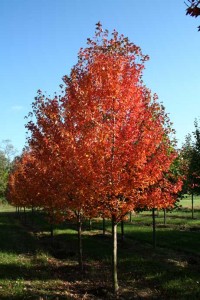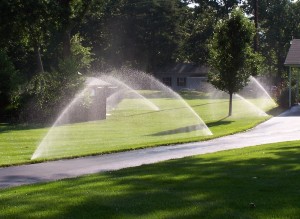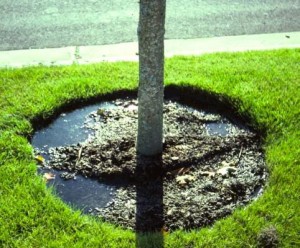 Our planting method, utilizing a tree spade, ensures a higher level of success than conventional ball and burlap or bare root planting.
Our planting method, utilizing a tree spade, ensures a higher level of success than conventional ball and burlap or bare root planting.
Watering, especially during the first year, is the most important factor in tree care and successfully establishing your new landscape. Following these simple tips will guarantee success.
The most important factor in taking care of your new tree is water. Too much water, too little water, or not watering deeply enough are all problems that can be easily avoided.
During the season, usually April through November, newly planted trees require the equivalent of 1” of a slow soaking rainfall each week. The goal is to give the tree a deep soaking of water. You should check the moisture of the soil once a week during the first season.
Check the soil moisture by probing the soil with a long blunt instrument like a flat-bladed screwdriver. The screwdriver should easily penetrate the soil. If the screwdriver is difficult to insert then more water is needed. If the screwdriver blade comes out of the ground with water on it then the soil is too wet.
Trees planted in the fall and winter need one deep watering as soon as planted.
Dormant deciduous trees will not require any watering until new growth appears in early spring.
Evergreens, planted in the fall, need to be watered as long as the weather is mild and the soil is not frozen. This is usually until mid to late December.
Large specimen trees are best watered with a hose placed near the base of the tree. Turn the water on to a slow trickle and allow the water to run continuously to completely saturate the root ball and the surrounding soil to a depth of 18” to 24”.
For a large tree this may take up to six hours. In most soils, the tree will need between 150 to 200 gallons of water.
Watering a tree lightly is insufficient to successfully establish a tree. Light, even frequent watering, will cause the tree roots to stay near the soil surface and not properly anchor the tree.
If slow release watering bags are installed, they need to be refilled once a week during the season. Several of these bags can be zipped together to provide enough water.

Automatic lawn sprinklers are usually adjusted to provide enough water for your lawn but this setting will not be enough to deeply and properly water a specimen tree. A longer run time set once a week is needed to give your tree a deep soaking. Increasing the run time and decreasing the frequency of the irrigation cycle is necessary.
Too much water on trees can be as damaging as not enough water.
 Ideally the soil should be moist but not dripping or flooded with water. Check the soil moisture by probing the soil with a long blunt instrument like a flat-bladed screwdriver. If the screwdriver blade comes out of the ground with water on it then the soil is too wet.
Ideally the soil should be moist but not dripping or flooded with water. Check the soil moisture by probing the soil with a long blunt instrument like a flat-bladed screwdriver. If the screwdriver blade comes out of the ground with water on it then the soil is too wet.
Your new specimen tree has been planted with a slow release fertilizer. Additional fertilizer is not necessary during the first growing season.
Care must be taken not to over fertilize your specimen tree. Too much fertilizer will cause excessive foliage growth, while decreasing root development. Root development during the first season is critical to the long-term success of the tree.
Properly pruning your specimen tree will create a lasting beauty for your landscape. There are a lot of misconceptions about proper tree pruning. Here are a few simple tips but for more extensive pruning consult with a certified aborist.
– Never top a tree.
– A tree can be lightly shaped any time of the year.
– Extensive pruning of established tree should be done in the winter or early spring.
– Dead branches can be removed anytime.
– It is better to leave a tree alone than to improperly prune it.
Here is a pruning guide from the Arbor Day Foundation
Shade Tree Farm uses the utmost care and attention to achieve a ninety-eight percent success rate.
Shade Tree Farm adheres to the latest industry standards in the care, growing and installation of your trees ensuring they will grow and increase in beauty and value for years to come. The newly planted trees’ survival after installation is largely dependent upon the care given.
With proper care, it is rare that a tree will fail to successfully establish. However, if your new tree fails within one year of the installation date, the tree will be fully replaced with a similar size and value. This is one time replacement. The replacement guarantee includes labor and material.